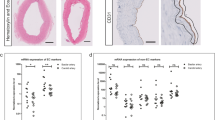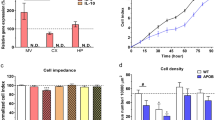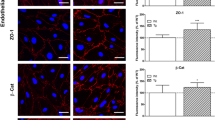Abstract
Oxidative stress and increased oxidation of low-density lipoprotein (oxLDL) through free radical-mediated tissue injury may be important factors in the development of extracranial atherosclerotic lesions. However, the roles of oxidative stress and hypercholesterolemia in intracranial atherosclerosis is less established. The induction of heme oxygenase (HO) is a cellular response to oxidative stress, and inducible HO (HO-1) may protect against oxidized lipids such as those produced by oxidative stress. We investigated the effects of oxLDL on cell and tissue viability, HO-1 and ferritin expression in extracranial and intracranial endothelial cells, and the arteries of cholesterol-induced atherosclerosis (CIA) Japanese quail. We report that cultured microvascular endothelial cells from the brain (QBMEC) and carotid (QCEC) differ in their response to oxidative stress. The QCECs are less responsive than QBMECs to oxidative stress induced by oxLDL, as evident by lower expression of HO-1 mRNA, HO activity, and ferritin levels. Furthermore, the higher levels of catalytic iron, thiobarbituric acid reactive substances, and lactate dehydrogenase released in QCECs indicated that these cells are more susceptible to oxidative stress than QBMECs. We also investigated the relationship between extent of atherosclerotic plaque deposition and the extracranial and intracranial arterial expression of HO-1 in quail. The common carotid and vertebral (extracranial) arteries had higher tissue cholesterol levels (starting at 2 weeks of cholesterol-supplementation) and a greater atherosclerotic plaque score (starting at 4 weeks of cholesterol-supplementation) compared with middle cerebral and basilar (intracranial) arteries, and this may be relevant to the effect of aging on the process of atherogenesis. The extracranial arteries also had early and greater levels of lipid peroxidation and catalytic iron coupled with lower expression of HO-1 protein, HO activity, and ferritin compared to the intracranial vessels. These observations suggest that the extracranial and intracranial arterial walls respond differently to oxidation of lipoproteins, and support the feasibility of increased HO-1 expression as a means of protection against oxidant injury.








Similar content being viewed by others
Abbreviations
- CIA:
-
Cholesterol-induced atherosclerosis
- HO:
-
Heme oxygenase
- QAEC:
-
Quail aortic endothelial cells
- QBMEC:
-
Quail brain microvascular endothelial cells
- EC:
-
Endothelial cells
- oxLDL:
-
Oxidized low-density lipoprotein
References
De Nigris F, Lerman LO, Condorelli M et al (2001) Oxidation-sensitive transcription factors and molecular mechanisms in the arterial wall. Antioxid Redox Signal 3:1119–1130
Witztum JL, Steinberg D (1991) Role of oxidized low density lipoprotein in atherogenesis. J Clin Invest 88:1785–1792
Postiglione A, Napoli C (1995) Hyperlipidaemia and atherosclerotic cerebrovascular disease. Curr Opin Lipidol 6:236–242
Mathur KS, Kashyap SK, Kumar V (1963) Correlation of the extent and severity of atherosclerosis in the coronary and cerebral arteries. Circulation 27:929–934
Murata K, Terasawa F, Hosoda H et al (1971) Relation of blood pressure and serum total cholesterol to severity of atherosclerotic lesions in aorta, coronary and cerebral arteries. Jpn Heart J 12:460–466
Mahley RW, Innerarity TL, Weisgraber KH et al (1977) Canine hyperlipoproteinemia and atherosclerosis. Accumulation of lipid by aortic medial cells in vivo and in vitro. Am J Pathol 87:205–225
Ito T, Shiomi M (2001) Cerebral atherosclerosis occurs spontaneously in homozygous WHHL rabbits. Atherosclerosis 156:57–66
Napoli C, Witztum JL, De Nigris F et al (1999) Intracranial arteries of human fetuses are more resistant to hypercholesterolemia-induced fatty streak formation than extracranial arteries. Circulation 99:2003–2010
Mayhan WG (2001) Regulation of blood-brain barrier permeability. Microcirculation 8:89–104
Yamaguchi M, Sato H, Bannai S (1993) Induction of stress proteins in mouse peritoneal macrophages by oxidized low-density lipoprotein. Biochem Biophys Res Commun 193:1198–1201
Agarwal A, Balla J, Balla G et al (1996) Renal tubular epithelial cells mimic endothelial cells upon exposure to oxidized LDL. Am J Physiol 271:F814–F823
Ryter SW, Alam J, Choi AM (2006) Heme oxygenase-1/carbon monoxide: from basic science to therapeutic applications. Physiol Rev 86:583–650
Wang LJ, Lee TS, Lee FY et al (1998) Expression of heme oxygenase-1 in atherosclerotic lesions. Am J Pathol 152:711–720
Morita T (2005) Heme oxygenase and atherosclerosis. Arterioscler Thromb Vasc Biol 25:1786–1795
Hoekstra KA, Godin DV, Cheng KM et al (2004) Protective role of heme oxygenase in the blood vessel wall during atherogenesis. Biochem Cell Biol 82:351–359
Hoekstra KA, Godin DV, Kurtu J et al (2003) Effects of oxidant-induced injury on heme oxygenase and glutathione in cultured aortic endothelial cells from atherosclerosis-susceptible and -resistant Japanese quail. Mol Cell Biochem 254:61–71
Hoekstra KA, Godin DV, Kurtu J et al (2003) Heme oxygenase and antioxidant status in cultured aortic endothelial cells isolated from atherosclerosis-susceptible and -resistant Japanese quail. Mol Cell Biochem 252:253–262
Velleman SG, Bacon W, Whitmoyer R et al (1998) Changes in distribution of glycosaminoglycans during the progression of cholesterol induced atherosclerosis in Japanese quail. Atherosclerosis 137:63–70
Mischeck U, Meyer J, Galla HJ et al (1989) Characterization of gamma-glutamyl transpeptidase activity of cultured endothelial cells from porcine brain capillaries. Cell Tissue Res 256:221–226
Teifel M, Friedl P (1996) Establishment of the permanent microvascular endothelial cell line PBMEC/C1-2 from porcine brains. Exp Cell Res 228:50–57
Griffin BA, Caslake MJ, Yip B et al (1990) Rapid isolation of low density lipoprotein (LDL) subfractions from plasma by density gradient ultracentrifugation. Atherosclerosis 83:59–67
Hoekstra KA, Nichols CR, Garnett ME et al (1998) Dietary cholesterol-induced xanthomatosis in atherosclerosis-susceptible Japanese quail (Cotunix japonica). J Comp Pathol 119:419–427
Chomczynski P, Sacchi N (1987) Single-step method of RNA isolation by acid guanidinium thiocyanate–phenol–chloroform extraction. Anal Biochem 162:156–159
Wohaieb SA, Godin DV (1987) Starvation-related alterations in free radical tissue defense mechanisms in rats. Diabetes 36:169–173
Gutteridge JM, Rowley RA, Halliwell B et al (1981) Superoxide-dependent formation of hydroxyl radicals in the presence of iron salts. Detection of ‘free’ iron in biological systems by using bleomycin-dependent degradation of DNA. Biochem J 199:263–265
Shih JC, Pullman EP, Kao KJ et al (1983) Genetic selection, general characterization, and histology of atherosclerosis-susceptible and -resistant Japanese quail. Atherosclerosis 49:41–53
Ishikawa K, Navab M, Leitinger N et al (1997) Induction of heme oxygenase-1 inhibits the monocyte transmigration induced by mildly oxidized LDL. J Clin Invest 100:1209–1216
Shi W, Haberland ME, Jien ML et al (2000) Endothelial responses to oxidized lipoproteins determine genetic susceptibility to atherosclerosis in mice. Circulation 102:75–81
D’Armiento FP, Bianchi A, de Nigris F et al (2001) Age-related effects on atherogenesis and scavenger enzymes of intracranial and extracranial arteries in men without classic risk factors for atherosclerosis. Stroke 32:2472–2479
Napoli C, Witztum JL, de Nigris F et al (1999) Intracranial arteries of human fetuses are more resistant to hypercholesterolemia-induced fatty streak formation than extracranial arteries. Circulation 99:2003–2010
Tenhunen R, Marver HS, Schmid R (1968) The enzymatic conversion of heme to bilirubin by microsomal heme oxygenase. Proc Natl Acad Sci U S A 61:748–755
Nakayama M, Takahashi K, Komaru T et al (2001) Increased expression of heme oxygenase-1 and bilirubin accumulation in foam cells of rabbit atherosclerotic lesions. Arterioscler Thromb Vasc Biol 21:1373–1377
Van Lenten BJ, Prieve J, Navab M et al (1995) Lipid-induced changes in intracellular iron homeostasis in vitro and in vivo. J Clin Invest 95:2104–2110
Otterbein LE, Zuckerbraun BS, Haga M et al (2003) Carbon monoxide suppresses arteriosclerotic lesions associated with chronic graft rejection and with balloon injury. Nat Med 9:183–190
Ishikawa K, Sugawara D, Wang X et al (2001) Heme oxygenase-1 inhibits atherosclerotic lesion formation in LDL-receptor knockout mice. Circ Res 88:506–512
Durante W, Kroll MH, Christodoulides N et al (1997) Nitric oxide induces heme oxygenase-1 gene expression and carbon monoxide production in vascular smooth muscle cells. Circ Res 80:557–564
Wu TW, Fung KP, Wu J et al (1996) Antioxidation of human low density lipoprotein by unconjugated and conjugated bilirubins. Biochem Pharmacol 51:859–862
Mayer M (2000) Association of serum bilirubin concentration with risk of coronary artery disease. Clin Chem 46:1723–1727
Juan SH, Lee TS, Tseng KW et al (2001) Adenovirus-mediated heme oxygenase-1 gene transfer inhibits the development of atherosclerosis in apolipoprotein E-deficient mice. Circulation 104:1519–1525
Meyers DG (2000) The iron hypothesis: does iron play a role in atherosclerosis? Transfusion 40:1023–1029
Juckett MB, Balla J, Balla G et al (1995) Ferritin protects endothelial cells from oxidized low density lipoprotein in vitro. Am J Pathol 147:782–789
Ponraj D, Makjanic J, Thong PS et al (1999) The onset of atherosclerotic lesion formation in hypercholesterolemic rabbits is delayed by iron depletion. FEBS Lett 459:218–222
Plump AS, Smith JD, Hayek T et al (1992) Severe hypercholesterolemia and atherosclerosis in apolipoprotein E-deficient mice created by homologous recombination in ES cells. Cell 71:343–353
Ishikawa K, Sugawara D, Goto J (2001) Heme oxygenase-1 inhibits atherogenesis in Watanabe heritable hyperlipidemic rabbits. Circulation 104:1831–1836
Napoli C, de Nigris F, Welch JS et al (2002) Maternal hypercholesterolemia during pregnancy promotes early atherogenesis in LDL receptor-deficient mice and alters aortic gene expression determined by microarray. Circulation 105:1360–1367
Ames BN, Shigenaga MK, Hagen TM (1993) Oxidants, antioxidants, and the degenerative diseases of aging. Proc Natl Acad Sci U S A 90:7915–7922
‘t Hoen PA, Van der Lans CA, Van Eck M et al (2003) Aorta of ApoE-deficient mice responds to atherogenic stimuli by a prelesional increase and subsequent decrease in the expression of antioxidant enzymes. Circ Res 93:262–269
Griendling KK, Sorescu D, Lassegue B et al (2000) Modulation of protein kinase activity and gene expression by reactive oxygen species and their role in vascular physiology and pathophysiology. Arterioscler Thromb Vasc Biol 20:2175–2183
Lin SJ, Shyue SK, Shih MC et al (2007) Superoxide dismutase and catalase inhibit oxidized low-density lipoprotein-induced human aortic smooth muscle cell proliferation: role of cell-cycle regulation, mitogen-activated protein kinases, and transcription factors. Atherosclerosis 190:124–134
Lehoux S (2006) Redox signalling in vascular responses to shear and stretch. Cardiovasc Res 71:269–279
Yee A, Sakurai Y, Eskin SG et al (2006) A validated system for simulating common carotid arterial flow in vitro: alteration of endothelial cell response. Ann Biomed Eng 34:593–604
De Keulenaer GW, Chappell DC, Ishizaka N et al (1998) Oscillatory and steady laminar shear stress differentially affect human endothelial redox state: role of a superoxide-producing NADH oxidase. Circ Res 82:1094–1101
Selivonchick DP, Roots BI (1977) Lipid and fatty acyl composition of rat brain capillary endothelia isolated by a new technique. Lipids 12:165–169
Acknowledgments
The authors would like to thank the technical staff at the Pulmonary Research Centre, St. Pauls Hospital, Vancouver, BC, Canada and Cindy Coy at Ohio State University for technical assistance. Special thanks to Prof. Carollo and Dr. B. Boal for their critical review. The quail endothelial cell antibody (QH1) was a gift from Dr. C.A. Buck, The Wistar Institute, Philadelphia, PA, USA. The quail smooth muscle antibody (1E12) was a gift from Dr. C.D. Little, Department of Cell Biology and Anatomy, Medical University of South Carolina, Charleston, USA. Research support to SGV was provided by state and federal funds appropriated to the Ohio Agricultural Research and Development Center, The Ohio State University.
Author information
Authors and Affiliations
Corresponding author
Rights and permissions
About this article
Cite this article
Hoekstra, K.A., Velleman, S.G. Brain microvascular and intracranial artery resistance to atherosclerosis is associated with heme oxygenase and ferritin in Japanese quail. Mol Cell Biochem 307, 1–12 (2008). https://doi.org/10.1007/s11010-007-9577-4
Received:
Accepted:
Published:
Issue Date:
DOI: https://doi.org/10.1007/s11010-007-9577-4




